With the path of the coronavirus and its long-term impact on the economy likely to be shrouded in uncertainty for some time, the importance of diversification in investment portfolios has been brought to the fore this year.
Traditional diversification methods have buckled under volatility in recent months, with asset correlations rising and even government bond prices falling in tandem with equities in the face of market stress. For some, faith in the principle of negative asset correlations has been lost and the diversification benefits of fixed income in particular have become more questionable.
"For investors who have historically relied on fixed income for diversification and liquidity, the asset class is a much less compelling proposition today than it used to be," argues Clark Fenton, manager of the RWC Diversified Return Fund. "The diversification benefits of the asset class is coming in at a higher cost in terms of returns foregone. We also believe it is much less likely to provide investors with what they need in times of market stress. Simply put, the risk-to-reward ratio is poor"
The downward trend of bond yields as well as the asset class's usefulness as a buffer to equity drawdowns has been well documented in recent years, with the latter primarily a result of ongoing central bank "hyper-activity", says Fenton: "Interest rates have continued to fall even as debt levels have increased. Central banks have become very accommodating at every turn of the business cycle. This addiction to central bank stimulus and reliance on easy financial conditions is severe. One of the outcomes is that fixed-income assets do not offer the same downside protection as they once did."
Fenton, aims to position his portfolio away from assets that rely on so-called easy financial conditions, and instead uses a range of liquid, low-cost and transparent alternative assets to drive returns. The strategy also invests—long and short—in interest rates, credit, commodities, FX and volatility strategies to ensure ‘genuine' diversification is present at all times. It also makes use of derivatives to mitigate risk.
Importantly, these strategies are deployed according to the positioning of the credit-cycle framework, which guides the team as to how much, and what kinds of risk to take in the portfolio.
For example, the fund was well positioned for the onset of the ‘deleveraging' phase of the credit cycle in mid-February, benefitting from long-volatility exposure and credit protection on US investment-grade debt.
"During the most acute deleveraging in March, our credit protection exposure was performing best [as] traditional fixed income suffered. The VIX shot up from a mid-teens level to the low 80s, and our volatility strategy contributed positively in February. As the index continued to climb we shifted a stance to whereby profits would come from declines in volatility. This small position complemented our solvency trades in credit protection."
By bringing these different components together, the fund was able to take gains in each distinctive month in the first quarter of 2020 - no mean feat as global stock markets fell. Fenton believes this result exemplifies why investors need to think more carefully about what diversification means and how to achieve it in the future.
"The way to achieve diversification needs to change going forward," he explains. "Investors need to be a lot more thoughtful about what it means, how they are going to achieve it, not mechanically relying on historical relationships across asset classes."
Click here to read more on how the RWC Diversified Returns Team look to take gains at cycle extremes from reversals in market sentiment and provide genuine diversification for investors
Disclaimer
The statements and opinions expressed in this article are those of the author as of the date of publication, and do not necessarily represent the view of RWC Partners Limited. This article does not constitute investment advice and the information shown above is for illustrative purposes only and should not be construed as a recommendation or advice to buy or sell any security. No investment strategy or risk management technique can guarantee returns or eliminate risks in any market environment. Past performance is not a guide to the future. The price of investments and the income from them may fall as well as rise and investors may not get back the full amount invested.











